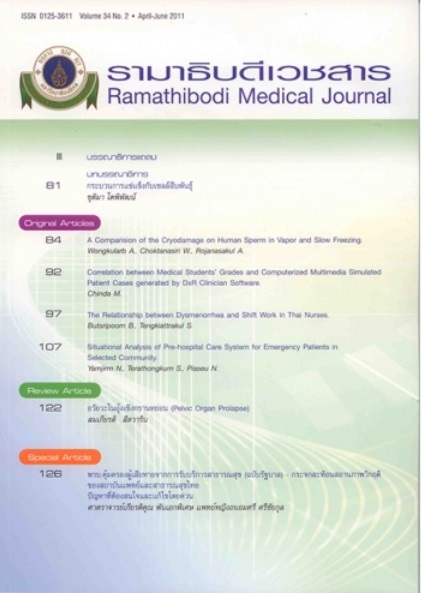A Comparision of the Cryodamage on Human Sperm in Vapor and Slow Freezing
Keywords:
Sperm cryopreservation, Vapor phase liquid nitrogen, Slow freezingAbstract
Objective: To evaluate the percentage of motile, vitality, morphology, and DNA integrity change on human sperm after freeze-thawing compared between vapor and slow freezing method.
Setting: The Infertility and ART Unit, Department of Obstetrics and Gynecology, Faculty of Medicine Ramathibodi Hospital.
Materials and Methods: In this experimental study, forty-five normozoospermic volunteer donors were used in the study. After swim up of the sperm, the sperm suspensions were divided into two equal parts, one part was kept as a control (frozen with vapor phase liquid nitrogen) and the other was used for the frozen with slow freezing. After one month of cryostorage, the sperm samples were thawed. The percentage of motile, vitality, morphology, and DNA integrity change were determined. The data was analyzed by a paired t-test.
Results: The percentage of the sperm motility with slow freezing was observed to decrease from 85.9 to 45.5 while that of the control declined to 40.7. The percentage of motile change of human sperm was significantly better following freezing with slow freezing than the control. The percentage of vitality change on human sperm assessed with slow freezing was significantly higher than in the vapor phase liquid nitrogen method. No significant differences in post thaw normal morphologically sperm and DNA integrity were compared between the vapor and slow freezing method.
Conclusion: The percentage of motile and vitality change of human sperm with slow freezing is superior to that of the vapor phase liquid nitrogen method.
References
Hammadeh ME, Askari AS, Georg T, Rosenbaum P, Schmidt W. Effect of freeze-thawing procedure on chromatin stability, morphological alteration and membrane integrity of human spermatozoa in fertile and subfertile men. Int J Androl. 1999;22(3):155-62. doi:10.1046/j.1365-2605.1999.00162.x.
Taylor PJ, Wilson J, Laycock R, Weger J. A comparison of freezing and thawing methods for the cryopreservation of human semen. Fertil Steril. 1982;37(1):100-3. doi:10.1016/s0015-0282(16)45985-6.
Hammadeh ME, Dehn C, Hippach M, Zeginiadou T, Stieber M, Georg T, et al. Comparison between computerized slow-stage and static liquid nitrogen vapour freezing methods with respect to the deleterious effect on chromatin and morphology of spermatozoa from fertile and subfertile men. Int J Androl. 2001;24(2):66-72. doi:10.1046/j.1365-2605.2001.00270.x.
Donnelly ET, McClure N, Lewis SE. Cryopreservation of human semen and prepared sperm: effects on motility parameters and DNA integrity. Fertil Steril. 2001;76(5):892-900. doi:10.1016/s0015-0282(01)02834-5.
Nallella KP, Sharma RK, Allamaneni SS, Aziz N, Agarwal A. Cryopreservation of human spermatozoa: comparison of two cryopreservation methods and three cryoprotectants. Fertil Steril. 2004;82(4):913-8. doi:10.1016/j.fertnstert.2004.02.126.
World Health Organization. WHO Laboratory Manual for the Examination of Human Semen and Sperm-Cervical Mucus Interaction. 4th ed. Cambridge, United Kingdom: Cambridge University Press; 1999. https://www.aab.org/images/WHO%204th%20manual.pdf.
Martins CF, Dode MN, Báo SN, Rumpf R. The use of the acridine orange test and the TUNEL assay to assess the integrity of freeze-dried bovine spermatozoa DNA. Genet Mol Res. 2007;6(1):94-104.
Branco CS, Garcez ME, Pasqualotto FF, Erdtman B, Salvador M. Resveratrol and ascorbic acid prevent DNA damage induced by cryopreservation in human semen. Cryobiology. 2010;60(2):235-7. doi:10.1016/j.cryobiol.2009.10.012.
Erenpreiss J, Spano M, Erenpreisa J, Bungum M, Giwercman A. Sperm chromatin structure and male fertility: biological and clinical aspects. Asian J Androl. 2006;8(1):11-29. doi:10.1111/j.1745-7262.2006.00112.x.
Irvine DS, Twigg JP, Gordon EL, Fulton N, Milne PA, Aitken RJ. DNA integrity in human spermatozoa: relationships with semen quality. J Androl. 2000;21(1):33-44.
Thomson LK, Fleming SD, Aitken RJ, De Iuliis GN, Zieschang JA, Clark AM. Cryopreservation-induced human sperm DNA damage is predominantly mediated by oxidative stress rather than apoptosis. Hum Reprod. 2009;24(9):2061-70. doi:10.1093/humrep/dep214.
Benchaib M, Braun V, Lornage J, Hadj S, Salle B, Lejeune H, et al. Sperm DNA fragmentation decreases the pregnancy rate in an assisted reproductive technique. Hum Reprod. 2003;18(5):1023-8. doi:10.1093/humrep/deg228.
Meseguer M, Santiso R, Garrido N, García-Herrero S, Remohí J, Fernandez JL. Effect of sperm DNA fragmentation on pregnancy outcome depends on oocyte quality. Presented in part at the 35th Meeting of the American Society of Andrology, Houston, Texas, April 10-13, 2010.
Vutyavanich T, Piromlertamorn W, Nunta S. Rapid freezing versus slow programmable freezing of human spermatozoa. Fertil Steril. 2010;93(6):1921-8. doi:10.1016/j.fertnstert.2008.04.076.
Simon L, Brunborg G, Stevenson M, Lutton D, McManus J, Lewis SE. Clinical significance of sperm DNA damage in assisted reproduction outcome. Hum Reprod. 2010;25(7):1594-608. doi:10.1093/humrep/deq103.
Simon L, Lutton D, McManus J, Lewis SE. Sperm DNA damage measured by the alkaline Comet assay as an independent predictor of male infertility and in vitro fertilization success. Presented in part at the 26th Annual Meeting of the European Society of Human Reproduction and Embryology. Rome, Italy, 27-30 June 2010. Hum.Reprod. 2010;25(Suppl 1):i118-i152.
Sakkas D, Alvarez JG. Sperm DNA fragmentation: mechanisms of origin, impact on reproductive outcome, and analysis. Fertil Steril. 2010;93(4):1027-36. doi:10.1016/j.fertnstert.2009.10.046.













